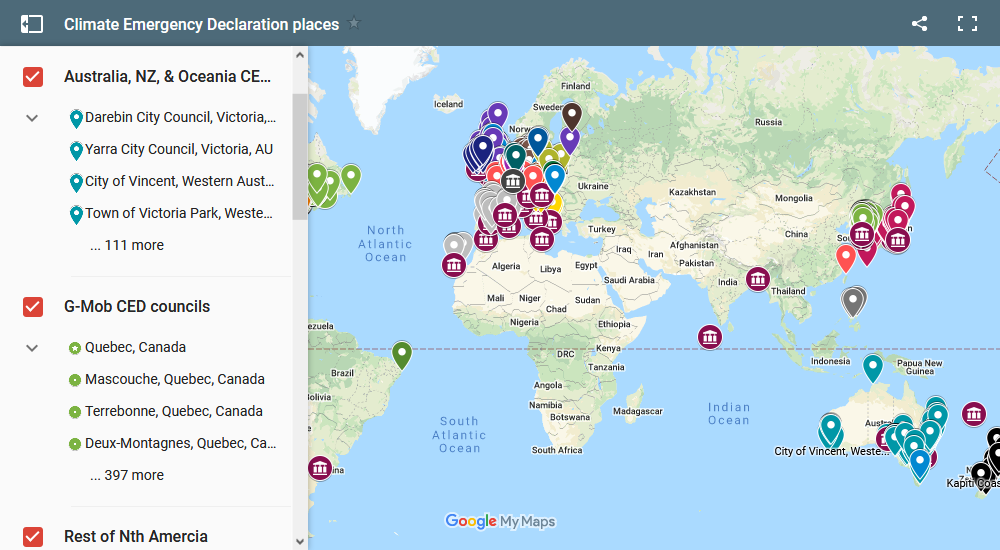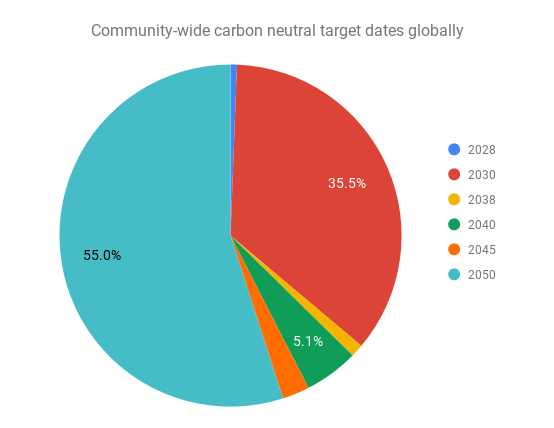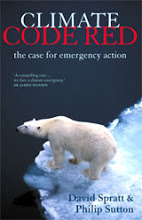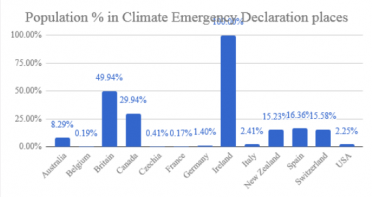This article by Bryony Edwards and Adrian Whitehead originally appeared in the Vote Planet blog and is reposted here with permission.
Since his sudden death on 12 June, much has been written about Philip Sutton, the visionary thinker behind the “climate emergency declaration”. Philip’s prolific lifetime of work is captured in this Guardian obituary.
Since the 1970s, Philip has published two seminal climate books, authored environmental legislation still in use, drafted legislation that the climate movement should be lobbying governments on, and shaped the climate conversation globally.
Philip was not a climate scientist but he grilled climate scientists to reveal the assumptions and realities behind often opaque scientific statements.
Philip worked long hours every single day at the theoretical “coalface” of climate thinking. Below the grassroots, down the end of a long tunnel – far from light, air, recognition, financial support. The work’s urgency was his drive; the urgency for a future for his kids and all vulnerable populations and ecosystems.
Anyone that recognised Philip’s brilliance is wondering how we carry on his legacy. Philip’s consolidated climate thinking on Climate Rescue is perfectly summarised in this November 2021 interview. Philip’s immediate thinking preceding his death is summarised in this email to the Victorian Climate Action Network. A group that was to work on his current Climate Rescue project is continuing that work.
Philip was always decades ahead of the “mainstream” climate movement, which has recognised and used some of his thinking but not the more difficult aspects. It is inevitable that we will have to engage with the these more difficult aspects if we decide to have a future.
This blogpost aims to capture the aspects of Philip’s core thinking that has not been widely understood or embraced by climate movements. It is a call for climate movements to understand and rally around Philip’s thinking in the quest to restore a safe climate.
The grief that many are feeling to lose this brilliant, big-hearted, deep thinker must be harnessed to implement what is likely the only path that will save us. A pathway that Philip envisaged over a decade ago.
How we restore a safe climate
Twenty years ago, when NGOs such as Greenpeace were campaigning on cuts of 60% emissions, Philip and a couple of others (Adrian Whitehead and Matt Wright) were looking at zero emissions. Not net-zero emissions still talked about today but true zero or a near zero emissions society achieved at emergency speed.
Philip’s thinking can be summarised by what we need to achieve for a viable future. The fundamentals have not altered in more than a decade and are increasingly validated by IPCC and other bodies as they catch up:
- Zero emissions, all sectors, achieved at emergency speed (less than 10 years).
- Massive drawdown of excess greenhouse gases to restore safe concentrations (100 years or so based on land use needs).
- “Cool the planet” (at emergency speed). We’ve already set off numerous feedback loops that make the first two actions alone not enough to save us.
The key here is that the only safe position is to reverse global warming and restore a safe climate (i.e. safe greenhouse gas concentrations and whatever else it takes). Without the combined three actions (zero, drawdown, cooling), we risk tipping into runaway climate change or Hothouse Earth, from which there is no conceivable return. The idea that we can stop warming at an arbitrary point and stay there is conjecture. Targets such as “zero by 2050” are political, not scientific; and suicidal based any analysis of the science.
And these three actions are required to occur at emergency speed. Philip was at pains to emphasise that acting at emergency speed requires:
- a declaration of the climate and ecological emergency so that firstly, everyone knows it’s an emergency and secondly, government has the authority to act, followed by
- mobilisation – acting on the emergency at emergency speed.
Elements of Philip’s thinking that got “mainstream” legs include
- The Climate Emergency Declaration. This got legs in 2016, when Philip’s council, Darebin (Vic) passed a motion recognising that we are in a climate emergency and all levels of government have responsibility to act. As some would be aware, this quickly spread to a handful of other Australian councils. Cedamia has tracked the global spread of the declarations since that point. Some positive change across participating governments resulted and has generalised to non-declared governments, but mobilisation, an intent of the campaign, was not adopted. The count is now over 2000 governments with national and state governments included. South Australia is a recent addition.
Philip’s (and David Spratt’s) thinking is succinctly captured in this Breakthrough paper, Climate Emergency Explored.
Elements of Philip’s thinking that have been adopted by the leading edge of the climate movement are:
- The idea of less than 10 years to zero emissions (ie not “net zero”) typified by the work of Beyond Zero Emissions and their Zero Carbon Australia plans, or Extinction Rebellion’s call for zero emission in five years.
- Drawdown to reduce greenhouse gas concentrations to pre-industrial levels. Two relevant books include Tim Flannery’s 2015 Atmosphere of Hope and Drawdown (2017) by Paul Hawken.
Two of Philip’s central ideas have have not gained traction with the leading edge or broader climate movement but are absolutely central to avoiding global climate catastrophe and restoring a safe climate are:
- The imperative combination of declaration PLUS mobilisation. Mobilisation (for emergency speed) is the goal; a declaration is the enabler. Mobilisation was put in the too-hard basket.
- Cooling the planet. Recognising that zero emissions, even if achieved today, is extremely unlikely to spare us from global climate catastrophe and that active solar radiation management would be needed.
Mobilisation and Cooling the planet are discussed in more detail in sections below.
Emergency declaration + mobilisation only work hand in hand
Declaration and mobilisation go hand in hand – with mobilisation the ultimate goal and declarations just a mechanism for mobilisation. For example:
- The COVID lockdowns and over 100 billion dollars made available (regardless of how well it was implemented) could not have happened without the initial state and federal declarations of the COVID emergency (Federally this was the COVID-19 Emergency Response Act 2020, states had their own acts).
- UK war mobilisation against Germany couldn’t have occurred without the UK intuitively declaring war. Naturally, the war could not have been won without ensuing mobilisation. Almost all efforts became focused on surviving and winning the war. For example, car manufacturers switched to making tanks, children from towns were moved to the country.
- Government and community responses during a bushfire emergency would not exist without first letting everyone know about the emergency (the declaration) and enabling emergency services to act quickly without red tape (mobilisation).
Philip outlined what a national Climate Emergency and Mobilisation Act would look like. It involved a lot of government restructuring and goal setting to prioritise the work needed to reverse global warming.
Philip emphasised the appropriate steps for target setting:
- Ask what we want to save (eg, Pacific Islands? Bangladesh? Coastal cities? The Great Barrier Reef).
- Backcast to ascertain what action is required to save what we want to save.
- Set targets based on the speed required to achieve the outcome.
Over the decades of inaction, the required action has become more urgent and extreme. There is no carbon/greenhouse gas budget.
Policy makers and mainstream Environmental NGOs (ENGOs) prefer to set targets based on what they think is “realistic” with a few tweaks to business as usual. This is suicidal when winning slowly means losing.
In 2013 Philip, working with a team that included Adrian Whitehead and Tiffany Harris, developed a plan for what mobilisation could look like at the local government level. This work later became core material that underpins the work of CACE (Council and community Action in the Climate Emergency).
Mobilisation is hard; local governments simply do not have the budget to achieve all that needs to be done. State governments and federal governments with their big economic and regulatory levers are the levels of government that could truly implement an emergency response, but state and federal governments in 2016 weren’t anywhere near declaring a climate emergency let alone mobilising. That’s why the Climate Emergency Declaration campaign was focused on local government. As far back as 2008 in this ABC interview with Robyn Williams and in his seminal 2008 book with David Spratt, Climate Code Red, Philip talked about going down to any level of governance – down to the household or individual if required, for traction on mobilisation.
Declaration + mobilisation is inconvenient. It cannot exist in a neoliberal frame, which prioritises infinite growth and the welfare of corporations. Mobilisation is a green-new deal, hard targets and working out what we do to meet those targets. It also means regulation to stop bad things, not just economic signals to slowly phase them out. Central governments need to wrest back power from decades of neoliberalism to make mobilisation happen.
On the idea of “economic signals”, Philip recently did a back-of-the-envelope calculation for a carbon tax that would get us to zero in under ten years. He estimated the tax would need to be around $300 a tonne – up a bit from the “ambitious” $50 we might hear. As Philip then said, “a $300 carbon tax would lead to chaos”. While a tax might have a role in subsets of activity, we need central planning to guide this kind of massive infrastructure work.
Cooling the planet
Point three of the pathway to restoring a safe climate, cooling the plant, is perhaps the most misunderstood.
Geoengineering as a whole is frowned upon by many people keen on saving the planet primarily because it is seen as an “out” for fossil fuels – that they might use it as a reason to keep emitting. Needless to say, we need to campaign for both “negative emissions” and cooling the planet at emergency speed.
The term geoengineering represents a broad range of options to cool the planet but Philip usually only referred to solar radiation management (increased albedo to reflect the sun) for cooling the planet, as in general solar radiation management represents a much lower risk option to create a global cooling than some of the options more broadly defined under the term geoengineering (eg BECCs).
Solar radiation management includes relatively low-tech options such as painting roofs white or highly reflective roads, to more complex options as reflecting sunlight back out into space by enhancing cloud formation, or maintain (reflective) levels of sulphur dioxide in our atmosphere as we progressively shut down coal power plants.
To reject the imperative of solar radiation management or alternatives outright is to not understand the inconvenient reality that at “equilibrium”, we have already reached around 2.5C of warming and built in 25 metres of sea level rise; most of this warming has not yet manifested in average surface temperatures due to:
- The thermal mass of the ocean that has absorbed the vast majority of warming; there is about a 30-year lag to this warming manifesting as surface temperature.
- Global dimming. We are currently “geoengineering” around 1C of cooling via global dimming or what would be solar radiation management if we were doing it intentionally. Sulphates from burning coal and other fossil fuels increase albedo. As we stop burning fossil fuels we will quickly need to maintain current rates of albedo if we want to avoid climate catastrophe. The IPCC has started to incorporate this reality into their modelling.
To reject the imperative of solar radiation management is to condemn millions of people to drowning land masses and all the other horrors that 2.5C+ of global warming can produce.
As such, zero emissions alone, if achieved today, would very likely not save us. Zero emissions alone is a narrative hangover from decades ago. It persists in climate circles. Zero emissions alone ignores the numerous feedback loops we have tripped that are speeding up warming, the 1C of cooling we are currently engineering, and the global lag in realised surface temperature.
If we care enough about people, populations, ecosystems, the web of life, a future for ourselves and our kids, we will take radical action to cool the planet. Any action should aim to minimise negative side effects; however, we’ve left it too long to imagine we come out of this unscathed. We need to go with the lesser of many evils.
Climate campaigns coming together?
Can the climate movement get behind Philip’s framework to restore a safe climate?
In a call for them to lead, the role of E-NGOs has to be highlighted here. There is a strong case that the large E-NGOs (yes, all of them) have held back progress as they clung to the idea that telling the truth wasn’t good business and campaigning for incremental action was the best way to get outcomes.
E-NGOs vehemently fought “emergency”, the E-word, until grassroots campaigns – starting in Darebin Vic, got the ball rolling with the initial climate emergency declaration in 2016.
There were tears, including Philip’s, among campaigners that had lobbied Darebin council when that first climate emergency motion passed in December 2016. (Special mention here to other Darebin campaigners, such as Adrian Whitehead for campaigning the council on a climate emergency declaration, Jane Moreton and her booklet that went global Don’t Mention the Emergency?, and Margaret Hender and Mik Aidt for their work on the Climate Emergency Declaration platform.)
When the large ENGOs finally noticed the emergency campaign had gone global, by about 2019, after it spread like wildfire through the UK councils, they raced to catch up to the bandwagon. Once they’d wrested the reins from grassroots campaigners, the large E-NGOs steered the wagon away from the trackless unknown of what a climate emergency declaration and mobilisation entails back onto the sealed road of feelgood rhetoric and incremental change. Targets were watered down, the idea of mobilisation vanished and the declaration plus a few council actions was the outcome.
Councils that had declared were looking at each other for guidance on how to mobilise. Some of them had a bit of a go and CACE provided a framework for that mobilisation. While there was resulting innovation that has influenced higher levels of government, none wanted to go too far out on a limb. This Breakthrough paper is a survey of what declared Australian councils had progressed around February 2020 with regard to climate emergency imperatives, and there is a 2022 Australian survey by Cedamia.
Since 2019, the rise of Extinction Rebellion, Greta Thunberg and Friday’s for Future (School Strikes) mean that grassroots are again visibly leading. However, ENGOs have become intertwined with School Strikes around the world.
XR’s demands are:
- Zero emissions by 2025
- Tell the Truth
- Citizens’ Assemblies to define appropriate action.
Fridays for Future’s (School strikes) demands are
- Keep the global temperature rise below 1.5°C compared to pre-industrial levels.
- Ensure climate justice and equity.
- Listen to the best united science currently available.
The Climate Emergency framework, as set out by Philip, goes a step further to outline non-negotiable actions required for a safe climate (zero, drawdown, cooling, all at emergency speed) and the essential mechanisms (declaration plus mobilisation) to achieve this.
Last word
Most governments will take the easiest path available so campaigners need to be laser sharp and unanimous in their messaging if they want a meaningful outcome.
Rather than campaigning for what we think governments will tolerate we need to campaign for what actually needs to be done, ie we need to campaign to reverse global warming and restore a safe climate.
Philip was optimistic that saving the planet was still feasible if we adhered to emergency speed to negative emissions (zero plus drawdown) and cooling the planet, underpinned by declaration plus mobilisation.
Can we rally around Philip’s core thinking to save ourselves?
If you’d like to receive future cedamia blog articles about new CEDs and council post-CED actions (one or two a month) directly to your inbox, click the Follow button below and set how you prefer to receive them.





























